In 2012 the Babson Survey Research Group (BSRG) put out a new report on usage and perceptions of open educational resources (OER) usage in higher education. Covered in this blog post, the 2012 report was really a combination of three separate surveys of academic leaders and faculty. In 2014 BSRG put out a new survey of faculty relating to OER, covered in this post, that I considered a significant milestone by providing actual data from a dedicated national survey to back up and clarify what many had assumed regarding OER. That report, however, was a one-off report, but the Hewlett Foundation and Pearson subsequently agreed to fund three annual longitudinal studies starting with the 2016 report released today. Per the press release:
Key findings from the report include:
- Faculty awareness of OER has increased, with 25% of faculty reporting that they were “Aware” or “Very Aware” of open educational resources, up from 20% last year.
- Only 5.3% of courses are using open textbooks (includes public domain and Creative Commons licensed).
- Large enrollment introductory undergraduate courses have adopted openly licensed OpenStax College textbooks at twice the rate (10%) as openly licensed textbooks among all courses.
- The most common factor cited by faculty when selecting educational resources was the cost to the students. After cost, the next most common was the comprehensiveness of the resource, followed by how easy it was to find.
- There is a serious disconnect between how many faculty consider a factor in selecting educational resources and how satisfied they are with the state of that factor. Faculty are least satisfied with the cost of textbooks, yet that is the most commonly listed factor for why they select resources.
- The barriers to adopting OER most often cited by faculty are that “there are not enough resources for my subject” (49%), it is “too hard to find what I need” (48%) and “there is no comprehensive catalog of resources” (45%).
Both Inside Higher Ed and the Chronicle of Higher Education covered this release and included additional interviews with co-author Jeff Seaman.
Longitudinal Data
One of my arguments in 2014:
This is valuable survey, and I would hope that BSRG succeeds in getting funding (hint, hint Hewlett and Pearson) to make this into an annual report with longitudinal data. Ideally the base demographics will increase in scope so that we get a better understanding of the unique data between institution types and program types. Currently the report separates 2-year and 4-year institutions, but it would be useful to compare 4-year public vs. private and even for program type (e.g. competency-based programs vs. gen ed vs. fully online traditional programs).
Not only did Hewlett and Pearson agree to fund the additional surveys, but the current report also includes expanded demographics in terms of faculty and course type (tenure / not tenured / not tenure track, part time / full time, teach online / blended / face-to-face) and in terms of institution type (2 year / 4 year, associates / baccalaureate / masters / doctoral / specialized) and institution size. There is even analysis of results by major academic discipline. All-in-all, this is a valuable report with important improvements from 2014.
The comparison data shows fairly significant increases in faculty awareness of OER (despite the numbers being quite low).
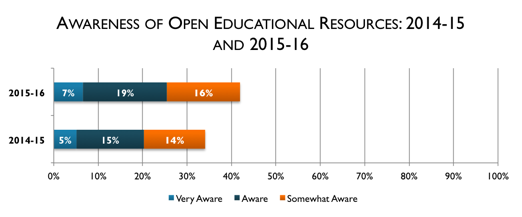
There is also an interesting comparison of perceived barriers to OER adoption since the previous report.
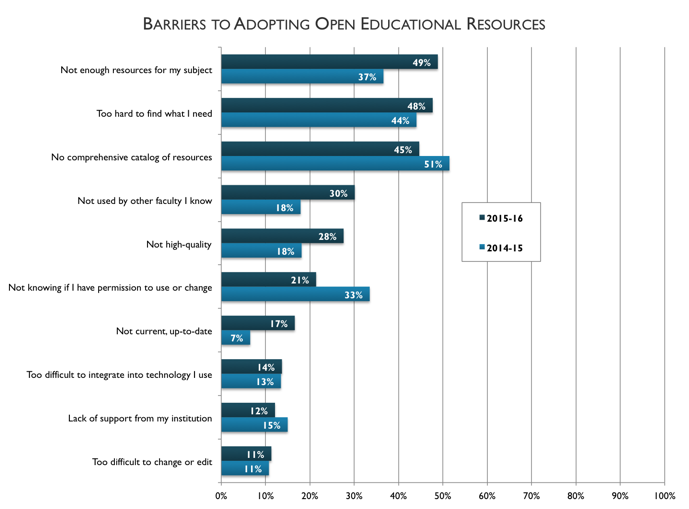
One interesting note – while awareness increased, the perceived barriers of “not enough resources” or “hard to find” or “not used by other faculty I know” actually increased. It looks like those faculty more recently becoming aware of OER are more mainstream in nature, strongly needing something easy to find and with comfort that other faculty are already adopting. Welcome to the chasm, my friends.
The Massive Disconnect
Given the expanded analysis, I want to focus on what I consider the real headline here. The most commonly-cited consideration that faculty listed when choosing required course materials was “cost to the student”, yet faculty are least satisfied with this same factor, and there is very light actual adoption of OER textbooks or supplementary material (including just 5.3% of courses using OER textbook).
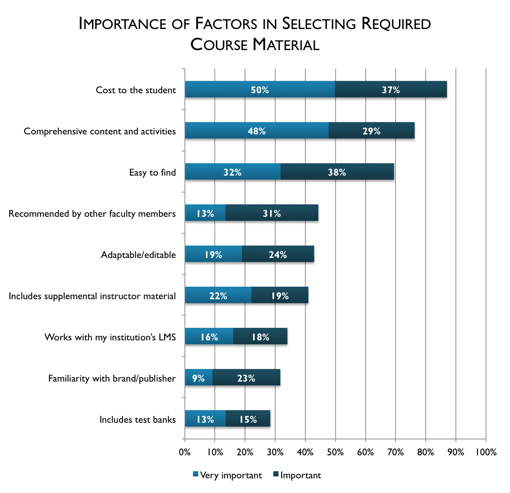
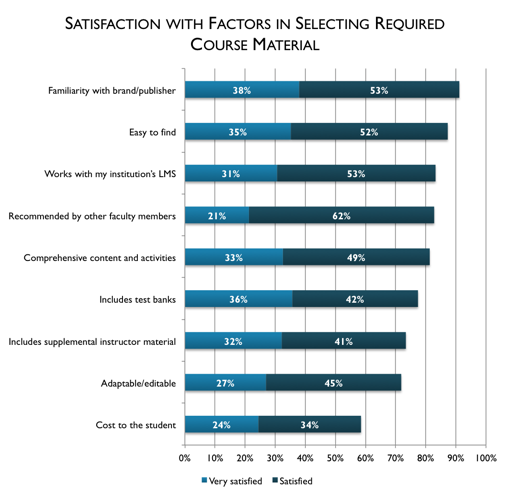
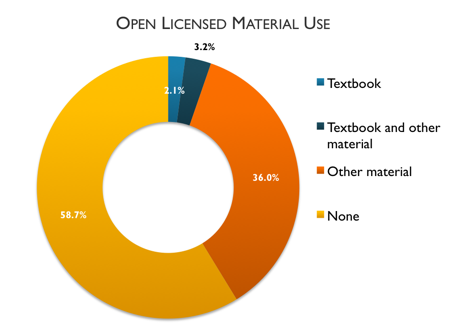
A cynical view would be that faculty don’t actually care about student costs but like to list it in survey responses. The BSRG authors, however, provide a thorough analysis with an alternate explanation on page 10 [emphasis added].
Is this answer a “feel good” response, or do faculty really base their decisions on the cost of the resources that they select? We know that the pattern of responses match those seen in other studies, with one finding 86% of faculty ranking the cost of material for students as a top issue in selecting course materials – nearly identical to these results. However, faculty actions may belie their stated level of concern; if cost were primary in their decision process we would expect to see far more low cost and no cost textbook options, both open and commercial, to have been.
It is critical to understand that while faculty are more likely to include cost than other factors in selecting educational materials; this does not mean that they consider cost the most important factor. The difference is subtle, but important. A typical faculty member reports five, six, or more factors as important to their selection process – cost is only one of them. The relative important of these factors varies by faculty member and by course for a particular faculty member. More faculty include cost in the list of factors that they consider, but for many it may be the least important.
In our previous study, when faculty were forced to select their top three factors from a list as opposed to rating each factor, only 2.7% included cost among their top three. This rate is far below that for other factors, such as working with the LMS, ease of finding OERs, and comprehensive content. A low rate on a forced priority selection indicates that faculty do not consider cost as a primary factor, but rather one to be considered only after their other criteria have been met.
Based on a reading of the open-ended comments in this study, it appears that faculty consider cost ceteris paribus – all other things being equal. Comments from faculty reinforce the idea that cost to the student is important, but only after content, relevance, quality, and presentation have been considered. Cost alone is not sufficient to drive the resource selection. A further issue is that faculty may not be aware of the cost of the materials that they select: a study by the New York Public Interest Research Group (NYPIRG) found that 28% of faculty reported that they did not typically know the prices of the books that they assigned.
For those promoting the usage of OER, this distinction about “all other things being equal” is critical. OER adoption must first and foremost be easy for faculty, saving time where possible, with a full set of resources available. It is only when faculty feel that these needs are met that their natural desire to save money for students will drive OER adoption decisions.
There’s a lot more in this report, including a significant inclusion of sample open-ended responses and data tables in the appendix. Go read the whole thing.
[gview file=”https://eliterate.us/wp-content/uploads/2016/07/openingthetextbook2016.pdf”]
Download the report here.
[…] By Phil HillMore Posts (417) In 2012 the Babson Survey Research Group (BSRG) put out a new report on usage and perceptions of open educational resources (OER) usage in higher education. Covered in this blog post, the 2012 report was really … Continue reading → […]